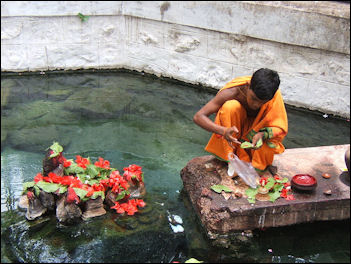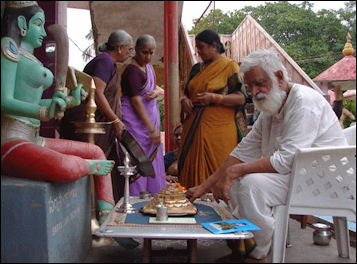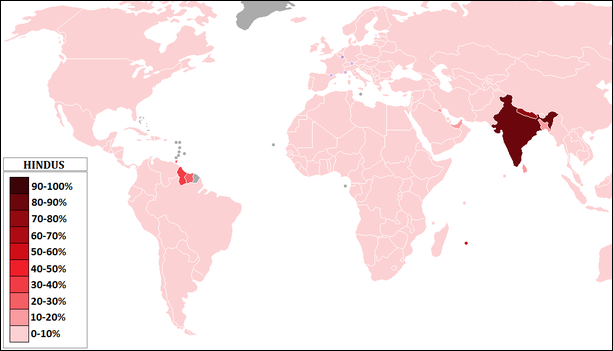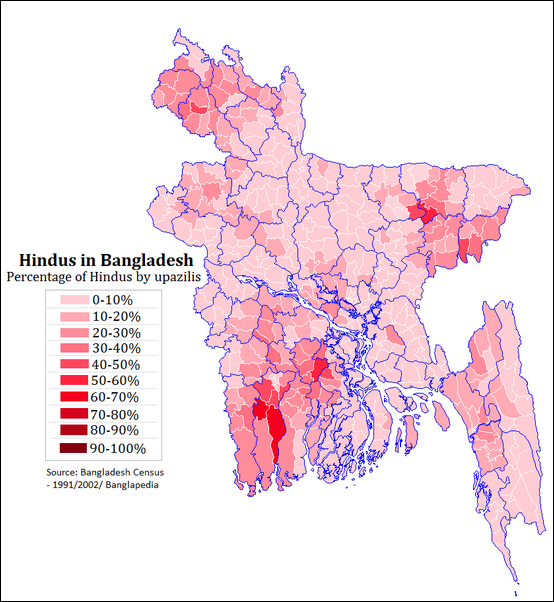HINDUS

Brahman performing puja A Hindu is a person who religiously follows Hinduism. It also has historically been term used to geographically, culturally, and religiously describe people living in the Indian subcontinent who were not Muslims, Christians or Buddhists. There are many different ways of being a Hindu in India, and a variety of different religious practices are prescribed in different sects of Hinduism. According to Mahatma Gandhi, "a man may not believe in God and still call himself a Hindu".
Hindus have also been described as people, most of whom are of South Asian descent, who recognize a multiplicity of gods (though they may only be devoted to one); who live in some form of nuclear or extended patrilineal family; and who believe they have one soul l normally reincarnated after death. [Source: “Encyclopedia of World Cultures Volume 3: South Asia,” edited by Paul Hockings, 1992]
Hinduism has variously been called a faith, religion and view of life. With around 1.2 billion people belonging to it (approximately 15 percent of the world population), Hinduism is the third largest religion in the world.
World religions (percent of the world population): 1) Christianity (31.6 percent); 2) Islam (25.8 percent); 3) Hinduism (15 percent); 4) non-religious and atheist (14.4 percent); 5) Chinese folk religions (6 percent); 6) Buddhism (6 percent); and 7) Other (1 percent). [Source: Statista]
Websites and Resources on Hinduism: Hinduism Today hinduismtoday.com ; India Divine indiadivine.org ; Wikipedia article Wikipedia ; Oxford center of Hindu Studies ochs.org.uk ; Hindu Website hinduwebsite.com/hinduindex ; Hindu Gallery hindugallery.com ; Encyclopædia Britannica Online article britannica.com ; International Encyclopedia of Philosophy iep.utm.edu/hindu ; The Hindu Religion, Swami Vivekananda (1894), .wikisource.org ; Journal of Hindu Studies, Oxford University Press academic.oup.com/jhs
RECOMMENDED BOOKS:
"An Introduction to Hinduism" by Gavin Flood Amazon.com ;
“India: A History" by John Keay Amazon.com ;
"The Wonder That Was India" by A.L. Basham Amazon.com ;
"The Hindus: An Alternative History" by Wendy Doniger; Amazon.com ;
“Hindu Myths: A Sourcebook” translated from the Sanskrit by Wendy Doniger (Penguin Classics, 2004) Amazon.com ;
“Myths and Symbols in Indian Art and Civilization” by Heinrich Zimmer (Princeton University Press, 1992) Amazon.com ;
“Indian Mythology” by Veronica Ions (Peter Bedrick 1984) Amazon.com
Where Hindus Live
About 80 percent of the Indian population regard themselves as Hindu. Outside India, the only places where Hindus dominate is Nepal (where they make up 90 percent of the population) and the Indonesian island of Bali and the African island of Mauritius. Hinduism is also strong in places with large numbers of people of Indian ancestry such as Trinidad and Fiji. Hindus are found in significant numbers in Sri Lanka, Malaysia, Suriname and Guyana and in the Indian communities in Britain, the United States, Canada and Africa. There are around 4 million Hindus in North America. Among those of non-Indian descent that have had a deep interest in Hinduism was the late Beatle George Harrison.

Guruji puja Hindus have traditionally been found in South Asia. Through emigration they have ventured far from the Indian subcontinent during the past century and a half. Hindus today to be found in significant numbers in the United Kingdom, the United States, Canada, Australia, Fiji, South Africa, Trinidad, Jamaica, Surinam, Guyana, the Kenya, Tanzania, Réunion, Mauritius, South Yemen; the Netherlands, Myanmar (Burma), Malaysia, Singapore, Brunei and Hongkong. [Source: Wikipedia +]
More than a thousand years ago Hindus migrated to some parts of Indonesia, where they are still identifiable today on the island of Bali and to a lesser extent on Java and Lombok. There are also have been identifiable Hindus associated with the Thai royal court, especially Brahmans. In recent decades thousands of Hindu men and women have gone to the Persian Gulf nations and taken up various generally low-paying, menial or service jobs but are not allowed to remain there and become citizens. [Source: “Encyclopedia of World Cultures Volume 3: South Asia,” edited by Paul Hockings, 1992 ]
In ancient times and the Middle Ages, Hinduism was the state religion in many Indianized kingdoms of Asia – from Afghanistan (Kabul) in the West and including almost all of Southeast Asia in the East (Cambodia, Vietnam, Indonesia, partly Philippines). The Khmer kingdom which produced Angkor Wat was Hindu. A small community of the Hindu Afghan Pashtuns who migrated to India after partition remain Hindus. The Indo-Aryan Kalash people in northern Pakistan practice a traditional indigenous religion which some scholars have characterized as a form of ancient Hinduism. There are many ethnic Ghanaian Hindus in Ghana, who have converted to Hinduism due to the efforts of Swami Ghanananda Saraswati and the Hindu Monastery of Africa. In the 20th century, Hinduism gained a number of followers among Western and European peoples largely through the work of Baba Premananda Bharati (1858–1914), Swami Vivekananda, A. C. Bhaktivedanta and Swami Prabhupada. +
Countries with the Greatest Number of Hindus
India — 1,120,000,000
Nepal — 28,600,000
Bangladesh — 13,130,102–20,149,351
Indonesia — 4,646,357–18,000,000
Pakistan — 4,444,870–8,000,000
United States — 3,230,000
Sri Lanka — 3,090,000
Malaysia — 1,949,850
United Arab Emirates — 1,239,610
United Kingdom — 1,030,000
[Source: Wikipedia]
Canada — 828,100
Australia — 684,000
Mauritius — 670,327
South Africa — 505,000
Saudi Arabia — 451,347
Singapore — 280,000
Fiji — 261,136
Myanmar — 252,763
Trinidad and Tobago — 240,100
Guyana — 190,966
Bhutan — 185,700
Italy — 180,000
Netherlands — 160,000
France — 150,000
Russia — 143,000
Suriname — 128,995
New Zealand — 123,534

Hindu distribution worldwide
Countries with the Greatest Proportion of Hindus
Percentage of Hindus in the Total Population
Nepal – 81.3 percent
India – 79.8 percent
Mauritius – 48.5 percent
Guyana – 28.4 percent
Fiji – 27.9 percent
Bhutan – 22.6 percent
Suriname – 22.3 percent
Trinidad and Tobago – 18.2 percent
Qatar – 13.8 percent
Sri Lanka – 12.6 percent
Bahrain – 9.8 percent
Bangladesh – 8.5 percent
Réunion – 6.8 percent
United Arab Emirates – 6.6 percent
Malaysia – 6.3 percent
Kuwait – 6 percent
Oman – 5.5 percent
Singapore – 5 percent
Indonesia – 3.86 percent
Australia – 2.7 percent
New Zealand – 2.62 percent
Seychelles – 2.4 percent
Pakistan – 2.14 percent
Hindu Demographics, Education and Politics
Hindus make up 79.8 percent of India’s population of 1.4 billion (2021 census). This works out to about 1.12 billion people. India contains 94 percent of the global Hindu population. Other significant populations are found in Nepal (28.6 million), Bangladesh (13 million) and the Indonesian island of Bali (around 4 million). A significant number of Hindus can also be found in Pakistan (4.4 million). The majority of Cham people in Vietnam and the Tenggerese people in Java, Indonesia also follow Hinduism. The largest proportion of Hindu Chams are in Ninh Thu Province. Hinduism is predicted to grow at a rate of 34 percent between 2010 and 2050., making it the third fastest-growing religion in the world after Islam and Christianity. [Source: Wikipedia]

Concentrations of Hindus is India
According to the Pew Research Center: Hindus in the U.S. and Europe are among the most educated religious groups where they live. In the U.S., Hindu adults have an average of 15.7 years of formal schooling – a full year more than the next most highly educated U.S. religious group (Jews), and nearly three years more than the average American adult (12.9 years), according to a 2016 Pew Research Center analysis. Similarly, the average level of education among Hindus in the UK is greater than that of other British adults (13.9 years vs. 12.2 years). These differences reflect the fact that religious minorities often have more education, on average, than a country’s majority, particularly when the minority group is largely foreign born and comes from a distant country. In India, Hindus are among the groups with the least education: 39 percent of Hindu adults have 10 or more years of schooling, compared with 48 percent of Sikhs and 47 percent of Christians, according to India’s 2019-2021 National Family Health Survey. [Source: Jonathan Evans, Pew Research Center, October 26, 2022]
Nearly two-thirds of Indian Hindus (64 percent) say it is very important to be Hindu to be truly Indian. A majority of Hindus (59 percent) also say speaking Hindi is crucial to being truly Indian. These beliefs about Indian national identity are strongly reflected in political views, and in levels of support for India’s ruling Bharatiya Janata Party (BJP), which is sometimes said to prioritize Hindu interests. Roughly half of Hindus who say they voted in the country’s 2019 election say they voted for the BJP (49 percent), but support for the BJP is considerably higher among those who say both being Hindu and speaking Hindi are very important to be truly Indian (60 percent). Although this group of Hindu BJP voters may see a special place for Hindus in India, they are just as likely as other Hindus to say respecting other religions is crucial to being truly Indian.
India’s Hindu Population Demographics
Based on data available in India's decennial census and the National Family Health Survey (NFHS), a Pew study found that India’s religious composition has changed little even though its total population has exploded. According to te BBC and the Pews stud, India's population has more than trebled following the 1947 division — from 361 million people in 1951, to more than 1.2 billion people in 2011. During this period, every major religion in India saw its numbers rise, the study found. The number of Hindus increased from 304 million to 966 million; Muslims grew from 35 million to 172 million; and the number of Indians who say they are Christian rose from 8 million to 28 million. [Source: Soutik Biswas, BBC, September 21, 2021]
“Hindus make up 79.8 percent of India's 1.2 billion people in the 2021 census. 94 percent of the world's Hindus live in India. Fertility has been by far the "biggest driver" of the modest amount of religious change in India. India gains roughly 1 million inhabitants every month and is now the world's most populous country. According to the BBC and the Pew study: “Muslims still have the highest fertility rate (2.6 children per woman in 2015) among the major religious groups, followed by Hindus (2.1). Jains have the lowest fertility rate at 1.2. The study says the general pattern is largely the same as it was in 1992, when Muslims had the highest fertility rate (4.4), followed by Hindus (3.3). "But the gaps in childbearing between India's religious groups are generally much smaller than they used to be," the study said.
“And the slowdown in population growth has been more pronounced among India's minority groups who outpaced Hindus in earlier decades. As the number of children Indian women had declined from an average of 3.4 per woman in the early 1990s to 2.2 in 2015, the rate among Muslims fell even more steeply from 4.4 to 2.6. Over a period of 60 years, the Muslim share of India's population grew by 4 percent, while the Hindu share declined by about the same amount.
Hindu Beliefs
Hinduism encompasses a variety of ideas about spirituality and traditions, but has no ecclesiastical order, no unquestioned religious authorities, no governing body, no prophets, and no binding holy book; Hindus may choose to be polytheistic, monotheistic, pantheistic, panentheistic, pandeistic, agnostic, atheistic, or humanistic. There are general practices but no specified dogma. According to professor Wendy Doniger, "ideas about all the major issues of faith and lifestyle – vegetarianism, nonviolence, belief in rebirth, even caste – are subjects of debate, not dogma." [Source: Wikipedia]
Hindus believe in four “purushartha” (aims of the living, or instrumental and ultimate goals): 1) “artha” (material prosperity); 2) “kama” (satisfaction of legitimate desires); 3) “dharma” (moral conduct and duties associated with one’s station in life); and 4) “moksha” (obtaining release from the cycle of deaths and rebirths). These aims are thought to apply to everyone, regardless of caste, from Brahmin to Untouchables.
According to the “advaita” philosophy the world and everything in it is an illusion and is one. There is only one divine principle in Hinduism and all the different gods are manifestations of this cosmic unity. Hindus often say, "We believe God is everywhere...We believe God is you, too." The only essential truth and desire is the one that is possessed within. Other things found in life are generally distortions and untruths. Many Hindus view life, existence and cosmology as too complicated to be followed as a simple creed. It is therefore up to an individual or group to pick the aspects of the religion that they feel applies to them.
Common among Hindus is the acceptance of the caste system as the structure of society. For virtually all Hindus, even those in revolt against some aspects of the system, caste is taken for granted as the way of life. To be considered Hindu, a group must identify itself in some way as a unit in the caste hierarchy. One cannot join a caste; one is born into it and lives, marries, and dies in it. [Source: Wikipedia]
See Separate Article BASIC HINDU BELIEFS: factsanddetails.com

Hindus in Bangladesh
Hindu Practices and Views of God and Reincarnation
According to the Pew Research Center: Many Indian Hindus regularly perform puja – a worship practice that often involves prayer and giving offerings to deities. Most Hindus in India perform puja at home daily (55 percent). Fewer Hindus perform puja at temples daily (20 percent). Hindu women are much more likely than men to perform puja in their home daily (64 percent vs. 47 percent), but there is no gender gap when it comes to performing puja at temples (20 percent vs. 21 percent). [Source: Jonathan Evans, Pew Research Center, October 26, 2022]
Nearly all Hindus in India celebrate Diwali, but many also celebrate Christmas. More than nine-in-ten Indian Hindus (95 percent) celebrate Diwali, while roughly one-in-five (17 percent) say they participate in Christmas festivities and 7 percent say they celebrate Muslim Eid, according to Pew Research Center’s 2019-2020 survey. (In the U.S., 95 percent of Indian American Hindus celebrate Diwali, according to a 2012 survey.) Diwali is among the most popular religious holidays in India and is also celebrated by large majorities of the country’s Jains (98 percent), Sikhs (90 percent) and Buddhists (79 percent), as well as by substantial minorities of Christians (31 percent) and Muslims (20 percent).
Four-in-ten Indian Hindus believe in reincarnation. Although reincarnation is a mainstream teaching in Hinduism, fewer than half of Hindus express belief in this teaching. College-educated Hindus are slightly less likely than others to say they believe in reincarnation (34 percent vs. 41 percent).
The vast majority of India’s Hindus believe in God (98 percent), including eight-in-ten who say they believe in God with absolute certainty. Even though Hinduism is sometimes referred to as a polytheistic religion, very few Hindus (7 percent) take the position that there are multiple gods, according to the Center’s 2019-2020 survey. The prevailing view, held by 61 percent of Hindus, is that there is one God “with many manifestations.” About three-in-ten Indian Hindus (29 percent) say simply: “There is only one God.”[Source: Jonathan Evans, Pew Research Center, October 26, 2022]
The survey asked Hindus who say they believe in God which god(s) they feel closest to, seeking to measure the concept of ishta devata (“personal god”). The vast majority of Hindus selected more than one god or indicated that they have many personal gods. Hindus most commonly feel close to Shiva (44 percent). Roughly three-in-ten Hindus say they feel closest to Ganesha (32 percent) and Lakshmi (28 percent), and 17 percent of Indian Hindus feel closest to Lord Ram – three deities commonly honored during Diwali.
Hindu Denominations
For most of its adherents, Hinduism encompasses a variety of devotions and sects that center on one or more of the great gods and are expressed at least partly in a regional context. The great tradition recognizes a trinity of gods, who are actually forms of absolute Brahman: Brahma the creator, Vishnu the preserver, and Shiva the destroyer. Brahma receives little notice; everyday devotion tends to center on the worship of Vishnu and Shiva (known by a variety of names) and their countless respective consorts. [Source: Library of Congress]
Currently, the four major denominations of Hinduism are Vaishnavism, Shaivism, Shaktism, and the Smarta tradition. The Smarta tradition, also called Smartism, is a movement in Hinduism that developed and expanded with the Puranas genre of literature. It reflects a synthesis of four philosophical strands, namely Uttara Mīmā sā, Advaita, Yoga, and theism.
The worship of Shiva has generally found adherents among the higher castes. Worship of Vishnu more explicitly cuts across caste lines by teaching the fundamental oneness of humankind in spirit. Vishnu worship in Bengal expresses the union of the male and female principles in a tradition of love and devotion. This form of Hindu belief and the Sufi tradition of Islam have influenced and interacted with each other in Bengal. Both were popular mystical movements emphasizing the personal relationship of religious leader and disciple instead of the dry stereotypes of the Brahmans or the ulama. In Bengal, worship of Vishnu frequently occurs in a small devotional society (samaj)..*
Demographics of major Hindu denominations (Tradition, Followers, percent of the Hindu population, percent of the world population, Follower dynamics, World dynamics)
Vaishnavism — 640,806,845 — 67.6 — 9.3 — Numbers Increasing — Numbers Increasing
Shaivism — 252,200,000 — 26.6 — 3.7 — Numbers Increasing — Numbers Increasing
Shaktism — 30,000,000 — 3.2 — 0.4 — Numbers Steady — Numbers Declining
Neo-Hinduism — 20,300,000 — 2.1 — 0.3 — Numbers Increasing — Numbers Increasing
Reform Hinduism — 5,200,000 — 0.5 — 0.1 — Numbers Increasing — Numbers Increasing
Total — 948,575,000 — 100 — 13.8 — Numbers Increasing — Numbers Increasing
[Source: World Religion Database, as of 2010]
India's Spiritual Market Valued at Over $30 Billion
India's spiritual and religious market has been valued to be worth tens of billions of dollars. In the mid 2010s, The Times of India said that this market was worth around $30 billion. According to Fortune, “they remain one of the most cited authorities on this figure; though newer estimates put that figure closer to $40 billion and entrepreneur Saumya Vardhan says her calculations place the market value at around $48 billion in 2016. [Source: Ambika Behal, Forbes, August 20, 2016]
“Around 80 percent of India’s population is Hindu — many continue to follow ancient traditions that have evolved little since around 500 BC. These play a huge part in daily life. Families contact priests to perform everything from astrological chart readings for the entire family to rituals for naming children to fixing financial problems, warding off evil spirits, wedding ceremonies, last rites — you name it.
Temple donations, the purchase of offerings, spiritual tourism, payments for ritual services, astrology services, traditional home décor services — the money being spent in India alone easily rockets into the billions of dollars. Priests typically specialize in an aspect of the religious practice; some are experts in career astrology, others may have stronger experience with wedding rituals, and so on. Vardhan says by utilizing the individual expertise of priests they are able to provide a better experience for customers participating in the ceremonies. “There are so many scams and scandals with spirituality, we want to make people aware of the science and facts behind these rituals,” says Vardhan, “no one is talking about the science behind it — it all has some significance, some science.”
Hindu Persecution and Conversion Issues
In recent years, religious conversion from and to Hinduism has been a controversial subject. Some state the concept of missionary conversion, either way, conflicts with the basic precepts of Hinduism. [Source: Wikipedia]
Hinduism in India and Nepal is widespread among many, both Indo-Aryan and non-Aryan ethnic groups. Outside of India religious conversion to Hinduism has a long history. Merchants and traders from India carried their religious ideas, which led to religious conversions to Hinduism outside India. The debate on proselytization and religious conversion between Christianity, Islam and Hinduism is more recent, and started in the 19th century.
The appropriateness of conversion from major religions to Hinduism, and vice versa, has been and remains an actively debated topic in India, Nepal, and in Indonesia. Religious leaders of some Hindu reform movements such as the Arya Samaj have launched Shuddhi movement to proselytize and reconvert Muslims and Christians back to Hinduism. Groups such as the Brahmo Samaj argue Hinduism is a non-missionary religion.
Hindus have experienced both persecution in the past and in modern times. These occur in the form of forced conversions, documented massacres, demolition and desecration of temples. Historic persecutions of Hindus occurred under Muslim rulers and by Christian missionaries In the Mughal Period, Hindus were forced to pay the Jizya. In Goa, the 1560 inquisition by Portuguese colonists is considered one of the most brutal persecutions of Hindus. Between 200,000 and one million people, including both Muslims and Hindus, were killed during the Partition of India. In modern times, Hindus face discrimination in many parts of the world and also face persecution and forced conversion6 in many countries, especially in Pakistan and Bangladesh
Image Sources: Wikimedia Commons
Text Sources: Internet Indian History Sourcebook sourcebooks.fordham.edu “World Religions” edited by Geoffrey Parrinder (Facts on File Publications, New York); “Encyclopedia of the World's Religions” edited by R.C. Zaehner (Barnes & Noble Books, 1959); “Encyclopedia of the World Cultures: Volume 3 South Asia” edited by David Levinson (G.K. Hall & Company, New York, 1994); . National Geographic, the New York Times, Washington Post, Los Angeles Times, Smithsonian magazine, Times of London, The New Yorker, Time, Newsweek, Reuters, AP, AFP, Lonely Planet Guides, Compton's Encyclopedia and various books and other publications
Last updated December 2023
